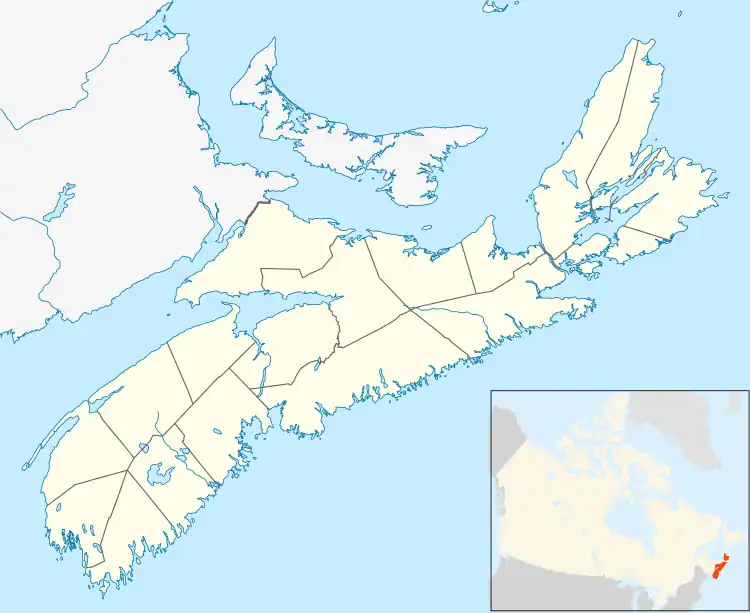Collegeville, Nova Scotia
Collegeville is the former name for the community of Ashdale, a community in Antigonish County, Nova Scotia, Canada. It is located roughly 15 kilometres (9.3 mi) southwest of the town of Antigonish. The highest temperature ever recorded in Nova Scotia occurred at the Collegeville climate station, when on 19 August 1935 the mercury climbed to 38.3 °C (100.9 °F).
Collegeville | |
|---|---|
Community | |
 Collegeville Location in Nova Scotia | |
| Coordinates: 45°29′28″N 62°00′54″W | |
| Country | |
| Province | |
| County | Antigonish County |
| Time zone | UTC-4 (AST) |
| • Summer (DST) | UTC-3 (ADT) |
| Area code | 902 |
The Environment Canada weather station in Ashdale retains the name Collegeville. The Collegeville post office opened June 1, 1887 and closed February 29, 1932.[1] During the 2nd World War, the weather station and the Ashdale school shared accommodations at the old school house at 15 Ashdale school road now owned by the Wallace family. Of note, the highest temperature ever recorded in NS was at this location. On August 19, 1935 a temperature of 38.3 was recorded at the schoolhouse in Ashdale.
Climate
| Climate data for Collegeville, Nova Scotia, 1981–2010 normals, extremes 1916–present | |||||||||||||
|---|---|---|---|---|---|---|---|---|---|---|---|---|---|
| Month | Jan | Feb | Mar | Apr | May | Jun | Jul | Aug | Sep | Oct | Nov | Dec | Year |
| Record high °C (°F) | 17.0 (62.6) |
15.5 (59.9) |
26.5 (79.7) |
29.0 (84.2) |
33.9 (93.0) |
35.0 (95.0) |
36.1 (97.0) |
38.3 (100.9) |
34.4 (93.9) |
28.3 (82.9) |
25.6 (78.1) |
19.0 (66.2) |
38.3 (100.9) |
| Average high °C (°F) | −1.5 (29.3) |
−1.2 (29.8) |
2.6 (36.7) |
8.2 (46.8) |
15.2 (59.4) |
20.4 (68.7) |
24.1 (75.4) |
23.8 (74.8) |
19.5 (67.1) |
13.1 (55.6) |
7.1 (44.8) |
1.6 (34.9) |
11.1 (52.0) |
| Daily mean °C (°F) | −6.5 (20.3) |
−6.1 (21.0) |
−2.1 (28.2) |
3.5 (38.3) |
9.3 (48.7) |
14.2 (57.6) |
18.3 (64.9) |
18.1 (64.6) |
13.9 (57.0) |
8.3 (46.9) |
3.2 (37.8) |
−2.6 (27.3) |
6.0 (42.8) |
| Average low °C (°F) | −11.4 (11.5) |
−11.0 (12.2) |
−6.8 (19.8) |
−1.3 (29.7) |
3.4 (38.1) |
7.9 (46.2) |
12.4 (54.3) |
12.5 (54.5) |
8.4 (47.1) |
3.4 (38.1) |
−0.7 (30.7) |
−6.7 (19.9) |
0.8 (33.4) |
| Record low °C (°F) | −34.4 (−29.9) |
−37.2 (−35.0) |
−30.6 (−23.1) |
−23.3 (−9.9) |
−8.0 (17.6) |
−4.4 (24.1) |
−1.1 (30.0) |
−0.6 (30.9) |
−6.7 (19.9) |
−10.0 (14.0) |
−18.9 (−2.0) |
−30.5 (−22.9) |
−37.2 (−35.0) |
| Average precipitation mm (inches) | 110.9 (4.37) |
87.9 (3.46) |
108.3 (4.26) |
94.2 (3.71) |
103.5 (4.07) |
102.5 (4.04) |
86.7 (3.41) |
97.6 (3.84) |
114.8 (4.52) |
140.6 (5.54) |
140.2 (5.52) |
127.9 (5.04) |
1,315.1 (51.78) |
| Average rainfall mm (inches) | 63.0 (2.48) |
45.3 (1.78) |
75.2 (2.96) |
81.4 (3.20) |
102.6 (4.04) |
102.5 (4.04) |
86.7 (3.41) |
97.6 (3.84) |
114.8 (4.52) |
139.8 (5.50) |
130.2 (5.13) |
85.3 (3.36) |
1,124.4 (44.27) |
| Average snowfall cm (inches) | 47.8 (18.8) |
42.6 (16.8) |
33.2 (13.1) |
12.8 (5.0) |
0.9 (0.4) |
0.0 (0.0) |
0.0 (0.0) |
0.0 (0.0) |
0.0 (0.0) |
0.8 (0.3) |
10.0 (3.9) |
42.7 (16.8) |
190.7 (75.1) |
| Source: Environment Canada[2][3][4][5] | |||||||||||||
References
- Refer to the index of geographical names for Nova Scotia at the official page and the current edition of The Nova Scotia Atlas.
- "Collegeville". Canadian Climate Normals 1981–2010. Environment Canada. Retrieved May 15, 2016.
- "December 2008". Canadian Climate Data. Environment Canada. Retrieved May 15, 2016.
- "April 2009". Canadian Climate Data. Environment Canada. Retrieved May 15, 2016.
- "March 2012". Canadian Climate Data. Environment Canada. Retrieved May 15, 2016.